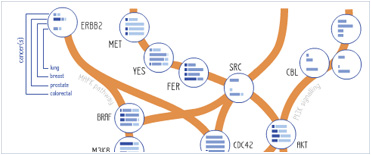LPHN2 Polyclonal Antibody
Purified Rabbit Polyclonal Antibody (Pab)
- SPECIFICATION
- CITATIONS
- PROTOCOLS
- BACKGROUND

Application
| IHC-P, IHC-F, IF, ICC, E |
|---|---|
| Primary Accession | O95490 |
| Reactivity | Rat, Pig, Dog, Bovine |
| Host | Rabbit |
| Clonality | Polyclonal |
| Calculated MW | 160 KDa |
| Physical State | Liquid |
| Immunogen | KLH conjugated synthetic peptide derived from human LPHN2 |
| Epitope Specificity | 531-630/1459 |
| Isotype | IgG |
| Purity | affinity purified by Protein A |
| Buffer | 0.01M TBS (pH7.4) with 1% BSA, 0.02% Proclin300 and 50% Glycerol. |
| SUBCELLULAR LOCATION | Cell membrane; Multi-pass membrane protein. |
| SIMILARITY | Belongs to the G-protein coupled receptor 2 family. LN-TM7 subfamily. Contains 1 GPS domain. Contains 1 olfactomedin-like domain. Contains 1 SUEL-type lectin domain. |
| SUBUNIT | Forms a heterodimer, consisting of a large extracellular region (p120) non-covalently linked to a seven-transmembrane moiety (p85) |
| Post-translational modifications | Proteolytically cleaved into 2 subunits, an extracellular subunit and a seven-transmembrane subunit. |
| Important Note | This product as supplied is intended for research use only, not for use in human, therapeutic or diagnostic applications. |
| Background Descriptions | This gene encodes a member of the latrophilin subfamily of G-protein coupled receptors (GPCR). Latrophilins may function in both cell adhesion and signal transduction. In experiments with non-human species, endogenous proteolytic cleavage within a cysteine-rich GPS (G-protein-coupled-receptor proteolysis site) domain resulted in two subunits (a large extracellular N-terminal cell adhesion subunit and a subunit with substantial similarity to the secretin/calcitonin family of GPCRs) being non-covalently bound at the cell membrane. While several transcript variants have been described, the biological validity of only one has been determined. [provided by RefSeq, Jul 2008] |
| Gene ID | 23266 |
|---|---|
| Other Names | Adhesion G protein-coupled receptor L2, Calcium-independent alpha-latrotoxin receptor 2, CIRL-2, Latrophilin homolog 1, Latrophilin-2, Lectomedin-1, ADGRL2 (HGNC:18582) |
| Target/Specificity | Expressed very widely in all normal tissues tested. Expression is variable in tumor cell lines, apparently elevated in some lines and absent or markedly reduced in others. |
| Dilution | IHC-P=1:100-500,IHC-F=1:100-500,ICC=1:100-500,IF=1:100-500,ELISA=1:5000-10000 |
| Format | 0.01M TBS(pH7.4), 0.09% (W/V) sodium azide and 50% Glyce |
| Storage | Store at -20 ℃ for one year. Avoid repeated freeze/thaw cycles. When reconstituted in sterile pH 7.4 0.01M PBS or diluent of antibody the antibody is stable for at least two weeks at 2-4 ℃. |
| Name | ADGRL2 (HGNC:18582) |
|---|---|
| Function | Orphan adhesion G-protein coupled receptor (aGPCR), which mediates synapse specificity (By similarity). Ligand binding causes a conformation change that triggers signaling via guanine nucleotide- binding proteins (G proteins) and modulates the activity of downstream effectors (By similarity). Following G-protein coupled receptor activation, associates with cell adhesion molecules that are expressed at the surface of adjacent cells to direct synapse specificity. Specifically mediates the establishment of perforant-path synapses on CA1-region pyramidal neurons in the hippocampus. Localizes to postsynaptic spines in excitatory synapses in the S.lacunosum- moleculare and interacts with presynaptic cell adhesion molecules, such as teneurins, promoting synapse formation (By similarity). |
| Cellular Location | Postsynaptic cell membrane {ECO:0000250|UniProtKB:Q8JZZ7}; Multi-pass membrane protein |
| Tissue Location | Expressed very widely in all normal tissues tested. Expression is variable in tumor cell lines, apparently elevated in some lines and absent or markedly reduced in others |

Thousands of laboratories across the world have published research that depended on the performance of antibodies from Abcepta to advance their research. Check out links to articles that cite our products in major peer-reviewed journals, organized by research category.
info@abcepta.com, and receive a free "I Love Antibodies" mug.
Provided below are standard protocols that you may find useful for product applications.
If you have used an Abcepta product and would like to share how it has performed, please click on the "Submit Review" button and provide the requested information. Our staff will examine and post your review and contact you if needed.
If you have any additional inquiries please email technical services at tech@abcepta.com.













 Foundational characteristics of cancer include proliferation, angiogenesis, migration, evasion of apoptosis, and cellular immortality. Find key markers for these cellular processes and antibodies to detect them.
Foundational characteristics of cancer include proliferation, angiogenesis, migration, evasion of apoptosis, and cellular immortality. Find key markers for these cellular processes and antibodies to detect them. The SUMOplot™ Analysis Program predicts and scores sumoylation sites in your protein. SUMOylation is a post-translational modification involved in various cellular processes, such as nuclear-cytosolic transport, transcriptional regulation, apoptosis, protein stability, response to stress, and progression through the cell cycle.
The SUMOplot™ Analysis Program predicts and scores sumoylation sites in your protein. SUMOylation is a post-translational modification involved in various cellular processes, such as nuclear-cytosolic transport, transcriptional regulation, apoptosis, protein stability, response to stress, and progression through the cell cycle. The Autophagy Receptor Motif Plotter predicts and scores autophagy receptor binding sites in your protein. Identifying proteins connected to this pathway is critical to understanding the role of autophagy in physiological as well as pathological processes such as development, differentiation, neurodegenerative diseases, stress, infection, and cancer.
The Autophagy Receptor Motif Plotter predicts and scores autophagy receptor binding sites in your protein. Identifying proteins connected to this pathway is critical to understanding the role of autophagy in physiological as well as pathological processes such as development, differentiation, neurodegenerative diseases, stress, infection, and cancer.

